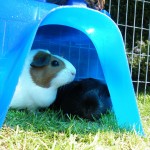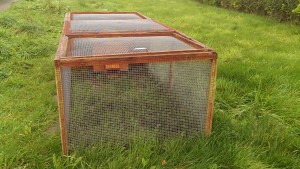SPRING
Don’t just stick your guinea pig out in a run on fresh grass. If it pigs out on new grass, it may suffer from gastric bloat – a real emergency. So put it out for only 15 minutes daily for the first week, slowly increasing the time week by week. Or cover up all but a small portion of the grass in the first week – about one square foot – slowly increasing the size week by week. Make sure the run is fox proof.
For indoor guinea pigs a room temperature of 18°C to 22°C is recommended (Kaiser et al., 2010). If you are putting your guinea pig in a run make sure that part of the run is sheltered from the rain or sun (McBride 2011).

c. Carrie and Simon Evans. www.petbehave.co.uk
SUMMER
Heat is more difficult for guinea pigs than cold (Kaiser et al., 2010). Guinea pigs suffer from heat stroke if temperatures rise above 27-30 degrees centigrade (Flecknell 2002) , so don’t keep their indoor cage in direct sunlight. Shade part of their run. Inspect the hutch daily and clean it carefully. Fly strike, when maggots hatch out in a dirty hutch and eat into the guinea pigs bottom, will kill it. Discuss the possibility of using Rearguard (anti-maggot spray for rabbits) with your vet. It kills maggots and lasts for several weeks.
If your guinea pig is getting a dirty bottom,and therefore at risk of flystrike, it may be because it is not eating its moist droppings and these are lying around in the hutch. This happens when a guinea pig is fed too rich a diet. Feed much more fibre in the form of more hay and grass, only a few pellets. Clean the hutch more often in hot weather.
Guinea pigs and other small pets can die of heat stress if they are left in hot cars. They should be transported in a wire cage with a solid base, not a closed box, with a piece of apple or celery to provide fluid. Either put on the air conditioning or leave an open window for the air to circulate during the journey.
Indoor guinea pigs must not be left in the sunlight or near a radiator or where there are drafts.
WINTER
Make sure that the front of the hutch is not open to driving rain – damp is bad for guinea pigs. In cold weather move the hutch inside a garden shed, outhouse or kitchen – not a garage since car fumes can kill them. If the hutch is not completely weatherproof, it is essential to buy a new hutch. Damp kills…. If the water bottle is freezing at night, it is too cold to keep the hutch out of doors. You MUST move it into the house or a shed.
You can also help keep guinea pigs warm at night with a SnuggleSafe microwave heat pad from www.snugglesafe.co.uk. These can be put in a hutch overnight even if there is no electricity supply. It’s vital to follow instructions, not to overheat, and to cover the device with cloth or its own covering, as well as hay, so the guinea pigs do not burn themselves on it. These stay warm for up to 12 hours.
If you have a dry covered box with hay for your guinea pig to retreat into, raised off the ground, then you can put your guinea pig out in its run even in some cooler weather (McBride 2011). But it must have a weather proof box as shelter like the one below.

Copyright behaviourist Bev Truss, www.petproblems.net
A run with a box inside for refuge in cold or wet weather
REFERENCES
Flecknell, P., (2002), ‘Guinea Pigs,’ eds Meredith, A. & Redrobe, S., BSAVA Manual of Exotic Pets, BSAVA, Fourth Edition, Quedgley, Gloucester, UK.
Kaiser, S., Kruger, C. & Sachser, N, (2010), ‘The Guinea Pig,’ in eds Hubrecht & Kirkwood, J., The UFAW Handbook on Care and Management of Laboratory and other Research Animals, Eight Edition, Wiley-Blackwell, Chichester, UK, 381-398
McBride, A., (2011), Guinea Pigs. Understanding and caring for your pet, Magnet & Steel.